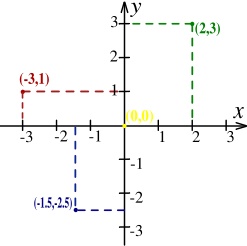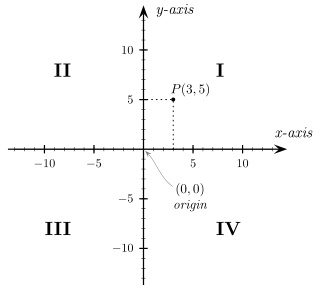Cartesian Coordinate System
A Cartesian coordinate system in two dimensions is
commonly defined by two axes, at right angles to each other, forming a plane (an
xy-plane). The horizontal axis is normally labeled x,
and the vertical axis is normally labeled y.
In a three dimensional coordinate system, another axis, normally labeled
z, is added, providing a third dimension of space measurement. The axes
are commonly defined as mutually orthogonal to each other (each at a right angle to
the other).
An illustration of the Cartesian coordinate system is provided below. The illustration contains four points: (2,3) in green, (−3,1) in red, (−1.5,−2.5) in blue and (0,0), the origin, in yellow.

The point of intersection, where the axes meet, is called the origin
normally labeled O. The x and y axes define a plane that is
referred to as the xy plane. Given each axis, choose a unit length, and
mark off each unit along the axis, forming a grid. To specify a particular point
on a two dimensional coordinate system, indicate the x unit first
(abscissa), followed by the y unit (ordinate) in the form
(x,y), an ordered pair.
The intersection of the two axes creates four regions, called quadrants, indicated by the Roman numerals I (+,+), II (−,+), III (−,−), and IV (+,−). Conventionally, the quadrants are labeled counter-clockwise starting from the upper right ("northeast") quadrant. In the first quadrant, both coordinates are positive, in the second quadrant x-coordinates are negative and y-coordinates positive, in the third quadrant both coordinates are negative and in the fourth quadrant, x-coordinates are positive and y-coordinates negative.



